Public Pier — No Fishing License Required
The angling piers of California are unique. At Redondo you find a little shop at the entrance with long rods and tackle to rent, and not far away the bait man, ready to provide clams, small fish, or anything you wish. Long Beach has several piers, and at Venice the pier is virtually a city street built out over the sea, with shops of various kinds and entertainments sufficient to divert the attention of the ghost of Walton. At the long, mile or more pier at Santa Monica a house stands at the sea-end, far out to sea, and the rail is lined with anglers who employ strange tackle. A little shop provides simple cheer to the physical man, and tackle can be rented and bait purchased. Back of the shop hangs a big scoop-net forty feet square, which is occasionally lowered and live bait caught, which is sold to the anglers whose ambition soars above sanddabs and mackerel to the other realms of yellowtail or big sharks, or a possible ray.
—Charles Frederick Holder, Salt Water Game Fishing, 1914
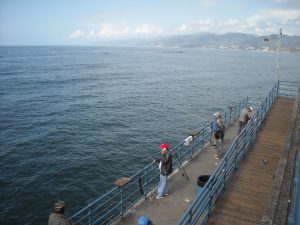
It was a mid-December day in 2013, nearly a century after Mr. Holder’s quote, and there I was standing on the end of the Santa Monica Pier. The morning radio had reported that a cold spell had descended on Los Angeles but the mid-60s day really didn’t seem that cold; nor did the fishing seem as slow as predicted by some. And though you no longer could buy live bait at the bait shop, the short, less than two-hour visit had produced seven fish—two white seaperch, two black seaperch, one sargo, a kelp bass, and a lizardfish. Perhaps they weren’t the large fish Holder preferred, a yellowtail or a big shark, but I was satisfied.
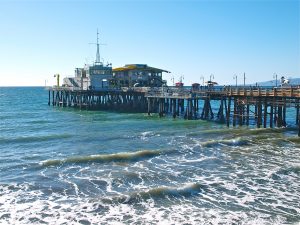
Although the weather was a little crisp, the sky was filled by big fluffy clouds and the pier was filled with people having a good time. Some were watching the street performers, some were riding the Ferris wheel, some were on their way to Mariasol, the Mexican food restaurant at the end of the pier, some were seeking out advice from Zoltar, and some were even fishing.
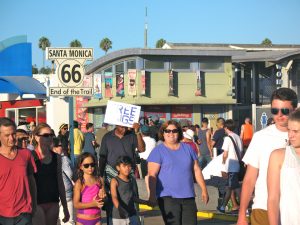
As I started to leave I paused for a few minutes to listen to a street performer (pier performer?) singing California Dreaming. The guitar, the harmonica, and the lyrics themselves seemed to perfectly match and echo the mellow mood on the pier that day. Yes, California Dreaming!
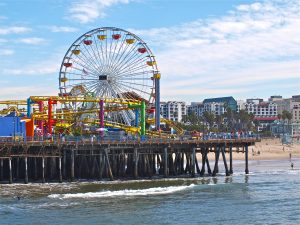
That mood hasn’t always been possible. When this pier, like many, was damaged by the 1983 El Niño storms, its future was debated, debated, and finally debated just a little bit more. (And a big raspberry along with a gooey bucket of hagfish slime goes to each of the misguided souls who argued against rebuilding the pier!)
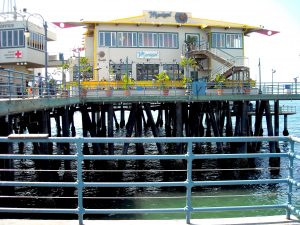
Much of the pier had been destroyed and it took years of meetings, studies and disagreements before an agreement and a major $30,000,000 renovation was started. On April 5,1990, one phase of the work was finished and a reconstructed Municipal Pier celebrated its rebirth. Today, nearly thirty years later, the pier is one of the “must see” attractions in Los Angeles (even if in Santa Monica), one filled day and night with visitors — some of whom are anglers.
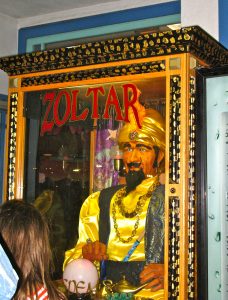
Of course, the Santa Monica Pier has long been one of California’s most famous piers, a historic and iconic structure to which every “pier rat” owes a visit. (I can see it now—“pier rat monks”—“piscatorial friars”—robed in blue jeans and t-shirts making their pilgrimage out to the hallowed pier while pulling pier carts and bringing suitable offerings for the gods of fish and piers.) A glimpse into the pier’s historic past is seen in the pictures displayed at the end of the pier but it’s just a glimpse, a mere blink of an eye, into a cast of characters and events that would make most movies proud.
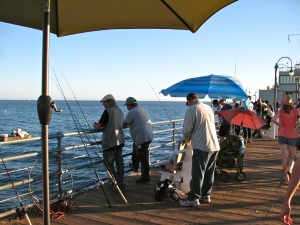
It’s much more than just a fishing pier!
Still, the fact that it’s busier than ever, and even more of a SoCal icon, must seem just a little puzzling and more than a little galling to those who fought against its being rebuilt. So be it! We’re just glad it’s here!
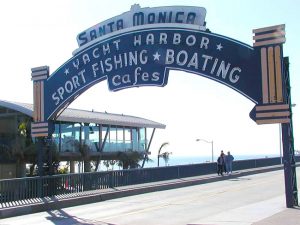
Environment. The pier (really two piers) is huge, extending nearly 2,000 feet seaward from its famous neon-lit arch entrance on Ocean Avenue (although only about half of this is over the water), and it offers several venues for visitors. Much of the front 2/3 of the pier is taken up by various shops and food stands while most of the old Newcomb Pier that adjoins the main Municipal Pier is taken up with parking and the Pacific Park amusement park.
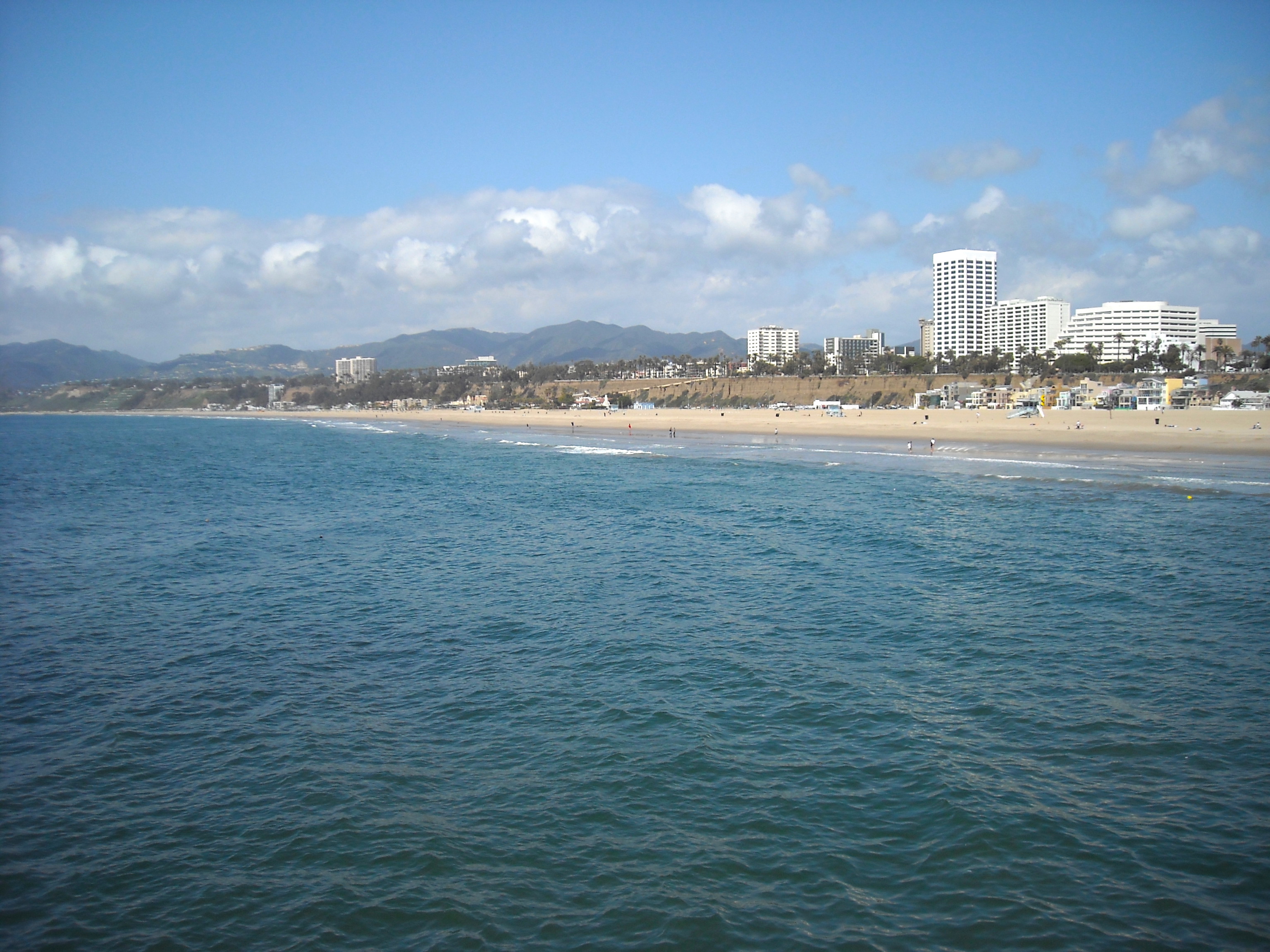
Santa Monica Bay aka “Crescent Bay” looking north
The pier fronts on the wide and heavily visited Santa Monica State Beach, an expanse of sand that runs from Will Rogers State Beach to the north, to Venice City Beach to the south. The beach area, as described by Lonely Planet (2005) as only they know how to describe, is a “Wide slab of sand where beach-umbrella-toting families descend like butterfly swarms on weekends to escape the inland heat.”
A short distance up the beach, sitting on the bluff overlooking PCH (Pacific Coast Highway) is Palisades Park and down shore, near the entrance to the pier sits the original “Muscle Beach” an area made famous by weightlifters like Arnold Schwarzenegger.
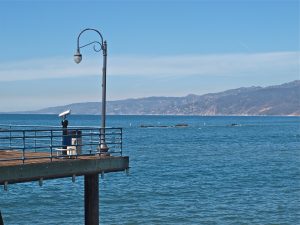
The old jetty is almost gone although the rocks provide a great environment for lobsters and bottom fish
The pier itself sits in the water of Santa Monica Bay and is wide open to the ocean, although remnants of a breakwater still exist a short distance out from the pier. That jetty, occasionally rumored to be rebuilt, is located approximately 550 feet out from the end of the pier. Once designed to form protection for boats (somewhat of an ocean-sea harbor), today the jetty is too broken up to lessen the affects of the sea when it decides to raise its ugly head. Long time regulars at the pier claim the increased water flow from the tides is one reason why the pier has shown a decrease in the quality of fish over the past few decades.
The bottom is primarily sand and mud with some old pilings and rocky areas underwater off to the right side of the pier. Because of the length of the pier, water is moderately deep in most of the end areas while most pilings have fairly good growths of fish-attracting mussels.
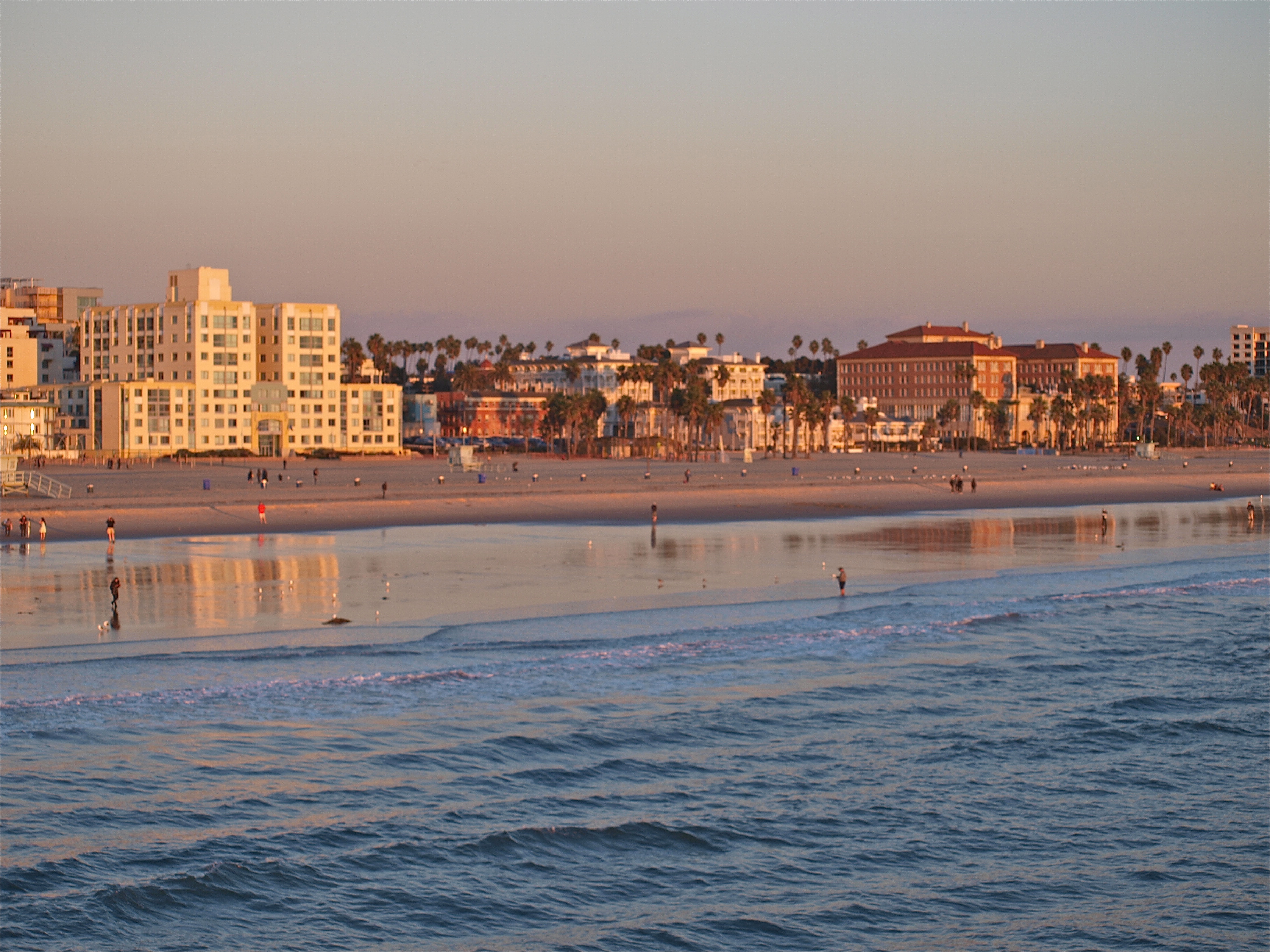
As diverse as the environment is the mix of people at the pier. Locals themselves are diverse as seen in the number of European, Mid-Eastern, Asian and Latino languages spoken by the “regulars” at the pier. In addition, the number of foreign visitors seems to increase each year, which means additional foreign languages being spoken. At times English almost seems rare.
Given the number of people who visit the pier, and the number of people on the pier trying to sell something—their songs, their pantomime skills, their artistic face painting or face sketching ability, and even their views on religion, it’s almost to be expected that some will etch themselves into the category of “characters.” It’s true today and it’s been true on the pier for many, many years.
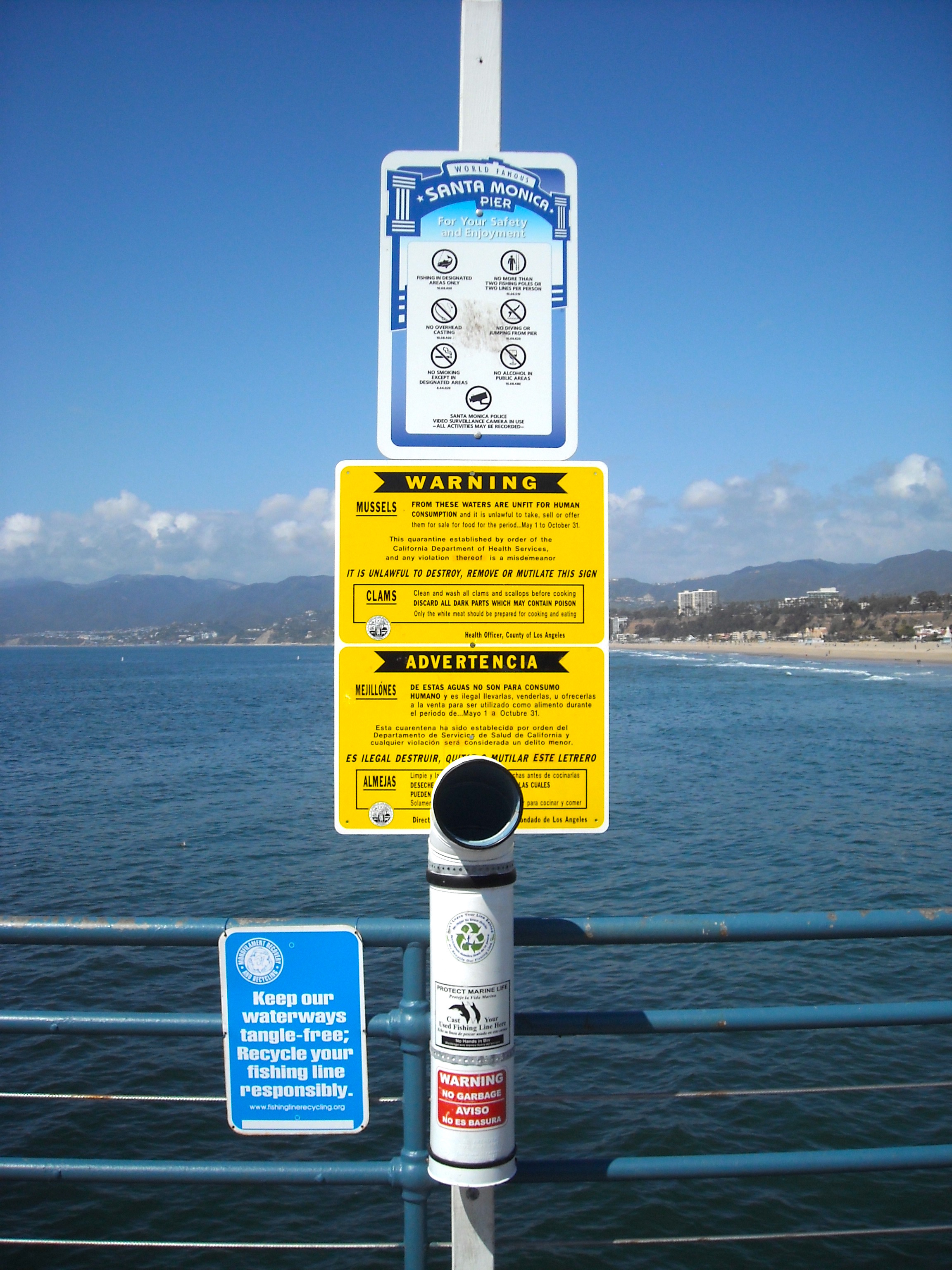
A friend of mine once wrote the following that describes some of the characters he saw during his time on the pier. And though the names may change, life on the pier remains a rarely boring existence, there’s just too much variety and excitement and too many characters that add to the excitement.
Some Characters I Knew
As a young fishing fanatic half a century ago, I spent every possible moment on the Santa Monica pier. Since I lived only four blocks away, it was easy to put in a great deal of time there, and it was soon apparent that there were many other regular visitors to that fascinating place. Some of them made a lasting impression.
For instance, there was the barrel-shaped lady that specialized in perch fishing. She reminded me of Tugboat Annie, feisty heroine of frequent stories in the Saturday Evening Post. She was cantankerous and opinionated, but kind enough to show me the correct way to open and shuck a mussel. (You put the knife point in where the tuft of hair comes out between the shells). She and another old-timer once nearly came to blows over the identity of a sargo he had caught. “Chinese croaker” and “Japanese croaker” were common names then applied to black croaker and sargo, and the argument raged over which term was appropriate for the catch in question.
It remains a mystery how these oriental appellations were derived in the first place. The lady became cool toward me after I had the temerity to doubt her opinion that sultry, humid weather was a cause of earthquakes.
The Halibut Expert was an aged black man who fished always at the same spot in the middle of the south side of the pier. He used homemade cane poles with rusty guides of twisted wire, wrapped on with friction tape. His reels were wooden sidewinders and the rigs were secured to the pier railing on ingenious rod holders made of scrap lumber and cord. However crude his equipment, that old man always went home with his share of flatfish.
There was also the gent I called the Corbina Man. A taciturn loner, he was rumored to be a shell-shocked veteran of the First World War and dressed always in the same olive-drab army-surplus clothing. He used an eastern type of surf rod of split bamboo with over-and-under guides and a long hickory “spring butt” that was supposed to facilitate casting. He liked huge gobs of fresh mussels for bait, wrapping them to the hooks with silk thread.
If the Corbina Man wasn’t tramping the beaches, he could often be found fishing from the south side of the pier, behind the ballroom, an area with very little foot traffic. He caught more corbina and croaker than anybody I ever saw, but he avoided company and would move if someone fished within a hundred yards of him. A surly grunt was the only reply I ever got from him, in response to my questions, so I learned to keep a respectful silence and study his techniques from a distance.
Before the breakwater was built there was a long, upward-slanting extension to the end of the pier that had no handrails. It was fenced-off, but resourceful anglers found a way around the barrier. At the extreme end there often could be seen a fisherman or Filipino extraction whose method was to whirl an 8-ounce sinker around his head and let it fly to carry his coiled handline a considerable distance. Two or three leaders with live bait would be snapped to the knotless cord and allowed to slide trolley-fashion down the line. he was very successful with halibut, bonito and barracuda, occasionally bringing in two fish at once…
Capt. Olaf Olsen, the epitome of a salty Scandinavian seafarer, was a fixture on the pier where he sold tickets for his boats and barges, Fox and Brown. He was a great booster of Santa Monica as a fishing center, and was always willing to tell a youngster a sea story, using his thick accent…
There were many more, of course, all characters whose faces and names were known to me then. I recall them all with delight for the color and interest they brought to a happy time in my life.
—Ed Ries, Looking Astern, South Coast Sportfishing, August 1982
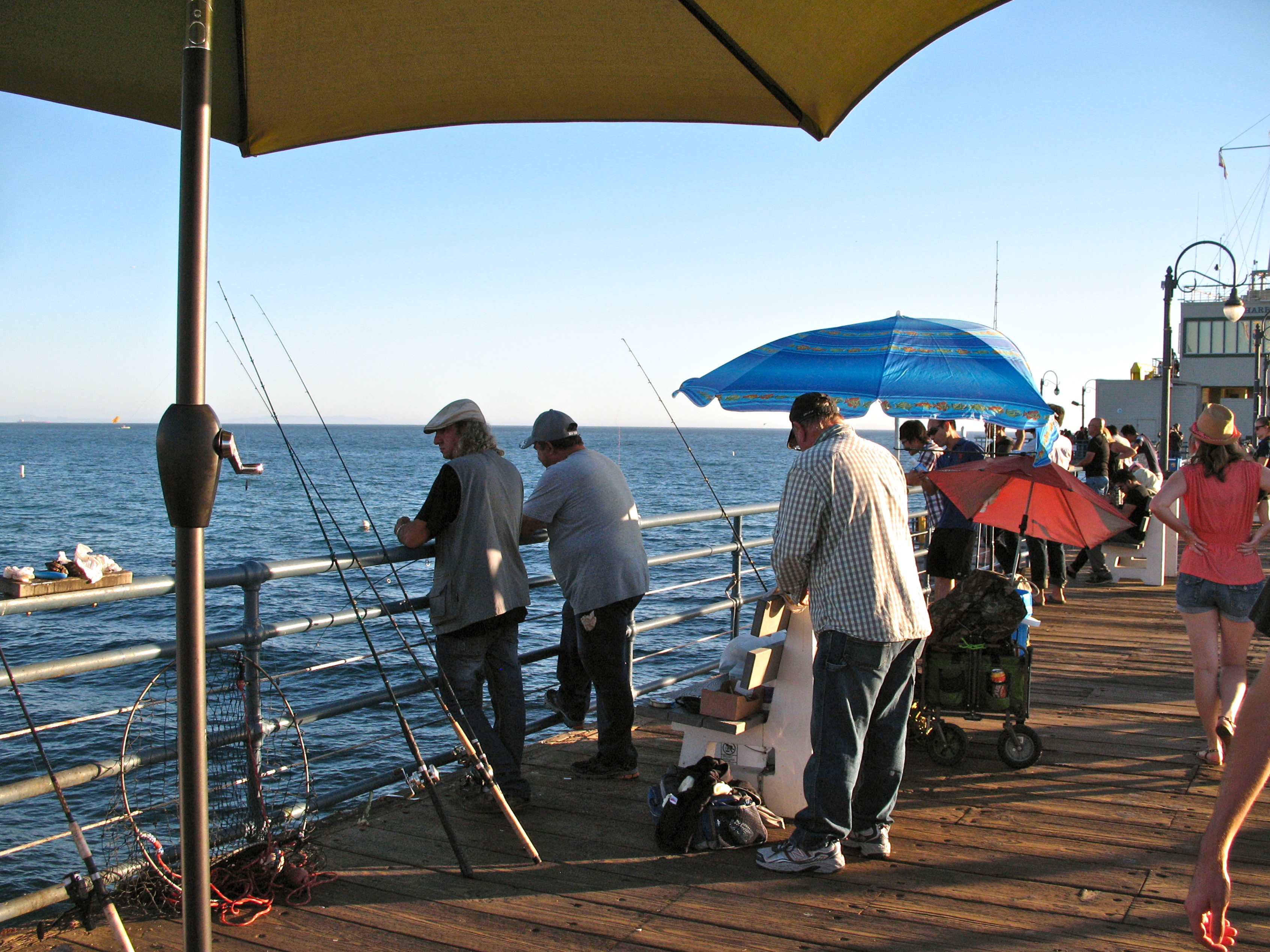
And then there’s this more recent tale.
Santa Monica Pier, Open 24 hours. Hire poles. Tuesday-Sunday only, $2 an hour, at the Rock Shop, which also sells bait, $3 a bag. The pier, whar’s left of it, is a real trip, especially on Saturday night. Hordes of kibitzers—some sober, others from planets not yet discovered—mill among the serious fisherfolk, ogling the creatures from the briny, offering suggestions (“Marshmallows man! Fish love ’em.”)
The pier though is quite safe, manned as it is by the Santa Monica Harbor Patrol, 24 hours. Says husky Harbor Patrolman Wayne Salkoski, himself a dedicated off-duty sport fisherman. “We’re in constant radio contact with the police.” The problem, as Salkoski sees it, is that a man—or woman or child—can get totally hooked on the alleged sport. The hooker as hookee. “It’s mesmerizing,” he says. “It’s relaxing. The ocean is a big pacificer. Especially under the moon, when they’re biting.”
Under the moon on a Saturday night, the Shark Slayer of North Hollywood pursues his esoteric craft with a single-mindness that blacks out the green-haired groupies who’ve clustered around him in an attitude approaching awe. Daniel Farmer his name is, known from Palos Verdes to Zuma, and his habits are ingrained. He catches mackerel in Redondo on one night, then uses them as shark bait the next night, in Santa Monica. “I don’t eat mackerel myself,” Farmer says. “Too oily. But the sharks love ’em.” Farmer hurtles a weighted line far out to sea, then slides slabs of mackerel down the line to the precise spot he’s chosen. “I’m setting up for a big something,” he says. “A shark, hopefully. A hundred-pounder. Got two 40s two nights ago. Best eating there is.”
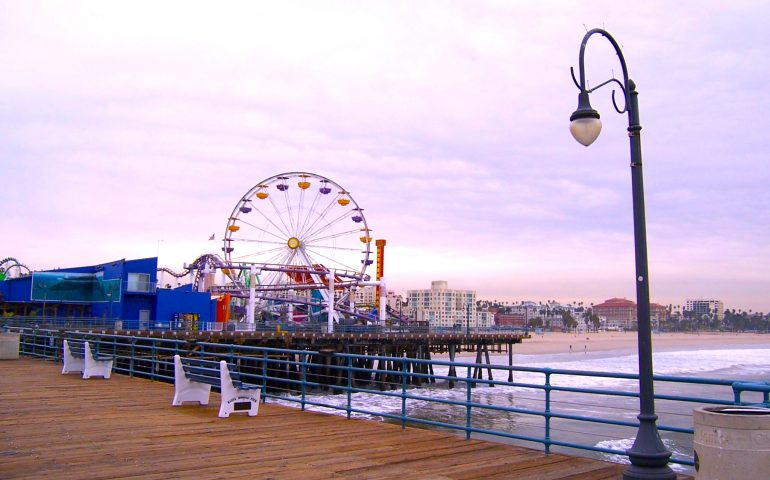
Santa Monica brings back some good memories, especially when I would go with my younger nephew fishing under the restaurant at the end. Always caught something, even if the day sucked for other fishermen. Under the Mariasol, I have caught my fair share of black, walleye, shiner( not common) and rainbow perch alongside sargo, black croaker, sand and calico bass. Have also caught Bonito, mackerel, halibut, turbot, sharks and rays, and the odd eel or octopus and crabs. That pier has a lot depending on the season, though I have had some good luck with Corbina and yellowfin croakers on the north side in front of the arcade facing the breaker waves. Sand crabs and mussels are key. If you fish the middle part of the pier under the pilings on either north or south sides in the spring, one can get some solid sargo action off mussels, bloodworms, or ghost shrimp.
I’m trying to find out the average height above the water for Santa Monica Pier.
?